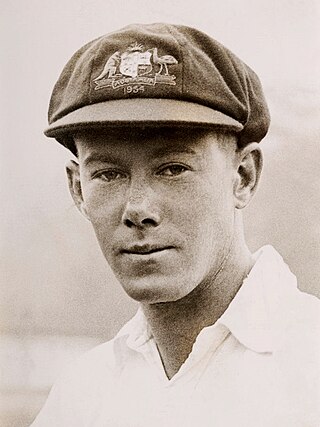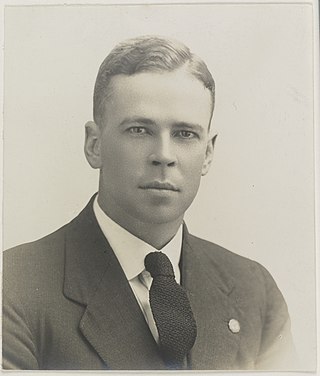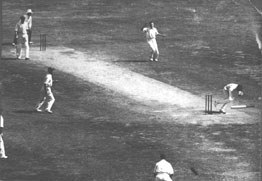
Harold Larwood was a professional cricketer for Nottinghamshire County Cricket Club and the England cricket team between 1924 and 1938. A right-arm fast bowler who combined extreme speeds with great accuracy, he was considered by many players and commentators to be the finest and the fastest fast bowler of his generation and one of the fastest bowlers of all time. He was the main exponent of the bowling style known as "bodyline", the use of which during the Marylebone Cricket Club (MCC) tour of Australia in 1932–33 caused a furore that brought about a premature and acrimonious end to his international career.

William Maldon Woodfull was an Australian cricketer of the 1920s and 1930s. He captained both Victoria and Australia, and was best known for his dignified and moral conduct during the tumultuous bodyline series in 1932–33. Trained as a schoolteacher, Woodfull was known for his benevolent attitude towards his players, and his patience and defensive technique as an opening batsman. Woodfull was not a flamboyant player, but was known for his calm, unruffled style and his reliability in difficult situations. His opening pairing with fellow Victorian Bill Ponsford for both his state and Australia remains one of the most successful in history. While not known for his tactical skills, Woodfull was widely admired by his players and observers for his sportsmanship and ability to mould a successful and loyal team through the strength of his character.

John Henry Webb Fingleton, was an Australian cricketer, journalist and commentator. The son of Australian politician James Fingleton, he was known for his dour defensive approach as a batsman, scoring five Test match centuries, representing Australia in 18 Tests between 1932 and 1938.

The Australian cricket team in England in 1948 is famous for being the only Test match side to play an entire tour of England without losing a match. This feat earned them the nickname of "The Invincibles", and they are regarded as one of the greatest cricket teams of all time. According to the Australian federal government, the team "is one of Australia's most cherished sporting legends". The team was captained by Don Bradman, who was making his fourth and final tour of England.

William Alfred Brown, was an Australian cricketer who played 22 Test matches between 1934 and 1948, captaining his country in one Test. A right-handed opening batsman, his partnership with Jack Fingleton in the 1930s is regarded as one of the finest in Australian Test history. After the interruption of World War II, Brown was a member of the team dubbed "The Invincibles", who toured England in 1948 without defeat under the leadership of Don Bradman. In a match in November 1947, Brown was the unwitting victim of the first instance of "Mankading".

William Harold PonsfordMBE was an Australian cricketer. Usually playing as an opening batsman, he formed a successful and long-lived partnership opening the batting for Victoria and Australia with Bill Woodfull, his friend and state and national captain. Ponsford is the only player to twice break the world record for the highest individual score in first-class cricket; Ponsford and Brian Lara are the only cricketers to twice score 400 runs in an innings. Ponsford holds the Australian record for a partnership in Test cricket, set in 1934 in combination with Don Bradman —the man who broke many of Ponsford's other individual records. In fact, he along with Bradman set the record for the highest partnership ever for any wicket in Test cricket history when playing on away soil

Stanley Joseph McCabe was an Australian cricketer who played 39 Test matches for Australia from 1930 to 1938. A short, stocky right-hander, McCabe was described by Wisden as "one of Australia's greatest and most enterprising batsmen" and by his captain Don Bradman as one of the great batsmen of the game. He was never dropped from the Australian Test team and was known for his footwork, mastery of fast bowling and the hook shot against the Bodyline strategy. He also regularly bowled medium-pace and often opened the bowling at a time when Australia lacked fast bowlers, using an off cutter. He was one of the Wisden Cricketers of the Year in 1935.

Alan Falconer Kippax was a cricketer for New South Wales (NSW) and Australia. Regarded as one of the great stylists of Australian cricket during the era between the two World Wars, Kippax overcame a late start to Test cricket to become a regular in the Australian team between the 1928–29 and 1932–33 seasons. A middle-order batsman, he toured England twice, and at domestic level was a prolific scorer and a highly considered leader of NSW for eight years. To an extent, his Test figures did not correspond with his great success for NSW and he is best remembered for a performance in domestic cricket—a world record last wicket partnership, set during a Sheffield Shield match in 1928–29. His career was curtailed by the controversial Bodyline tactics employed by England on their 1932–33 tour of Australia; Kippax wrote a book denouncing the tactics after the series concluded.

Archibald Jackson, occasionally known as Archibald Alexander Jackson, was an Australian international cricketer who played eight Test matches as a specialist batsman between 1929 and 1931. A teenage prodigy, he played first grade cricket at only 15 years of age and was selected for New South Wales at 17. In 1929, aged 19, Jackson made his Test debut against England, scoring 164 runs in the first innings to become the youngest player to score a Test century.
Marylebone Cricket Club organised the England cricket team's tour of Australia in the 1924–25 season. Australia won the Ashes series 4–1.
England won the 1926 Ashes series against Australia, winning the last Test of the series after the first four matches were drawn.
Australia won the 1934 Ashes series against England, winning two of the matches and losing one, with the other two tests drawn. The Australian tourists were captained by Bill Woodfull, while the home side were led by Bob Wyatt, with Cyril Walters deputising for Wyatt in the first Test.
The 1938 Ashes series between Australia and England was drawn. England and Australia won a Test each, with two of the other Tests drawn and the third game of the series, scheduled for Manchester, abandoned without a ball being bowled, only the second instance of this in more than 60 years of Test cricket. The Australians retained The Ashes.
1934 was the 41st season of County Championship cricket in England. England lost the Ashes with Don Bradman again the crucial difference between two very strong teams, Australia winning 2–1. Lancashire won the championship.
The Australia national cricket team toured South Africa from November 1935 to March 1936 and played a five-match Test series against South Africa. Australia won the Test series 4–0. Australia were captained by Vic Richardson; South Africa by Herby Wade.

A cricket team representing England toured Australia in the 1932–33 season. The tour was organised by the Marylebone Cricket Club and matches outside the Tests were played under the MCC name. The tour included five Test matches in Australia, and England won The Ashes by four games to one. The tour was highly controversial because of the bodyline bowling tactics used by the England team under the captaincy of Douglas Jardine. After the Australian tour was over, the MCC team moved on to play in New Zealand, where two further Test matches were played.

The Third Test of the 1932–33 Ashes series was one of five Tests in a cricket series between Australia and England. The match was played at the Adelaide Oval in Adelaide from 13 to 19 January 1933, with a rest day on 15 January. England won the match by 338 runs to take a series lead of 2 Tests to 1 with 2 Tests to play.

The Adelaide leak was the revelation to the press of a dressing-room incident during the third Test, a cricket match played during the 1932–33 Ashes series between Australia and England, more commonly known as the Bodyline series. During the course of play on 14 January 1933, the Australian Test captain Bill Woodfull was struck over the heart by a ball delivered by Harold Larwood. Although not badly hurt, Woodfull was shaken and dismissed shortly afterwards. On his return to the Australian dressing room, Woodfull was visited by the managers of the Marylebone Cricket Club (MCC) team, Pelham Warner and Richard Palairet. Warner enquired after Woodfull's health, but the latter dismissed his concerns in brusque fashion. He said he did not want to speak to the Englishman owing to the Bodyline tactics England were using, leaving Warner embarrassed and shaken. The matter became public knowledge when someone present leaked the exchange to the press and it was widely reported on 16 January. Such leaks to the press were practically unknown at the time, and the players were horrified that the confrontation became public knowledge.

During the five years 1928 to 1932, Herbert Sutcliffe played throughout the period for Yorkshire, continuing his highly successful opening partnership with Percy Holmes which reached its peak of achievement in 1932 when they set a then world record partnership for any wicket of 555, the stand including Sutcliffe's career highest score of 313. For England in Test cricket, Sutcliffe made his only tour of South Africa in 1927–28 and his second tour of Australia in 1928–29, during which he played arguably the greatest innings of his career. In the winter of 1930–31, he and Jack Hobbs went on a private tour of India and Ceylon which has caused some controversy in terms of their career statistics. Sutcliffe opened the innings for England throughout the period, playing in home series each season but most notably against Australia in 1930.












